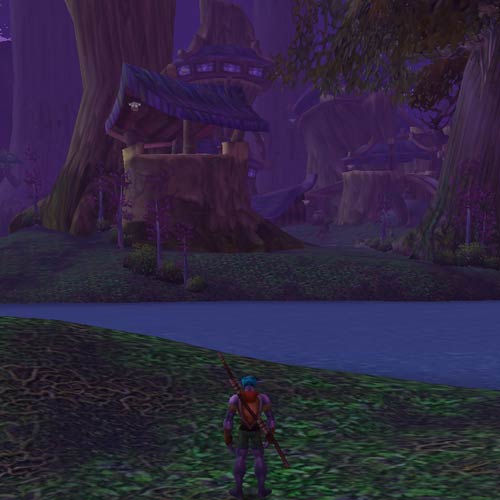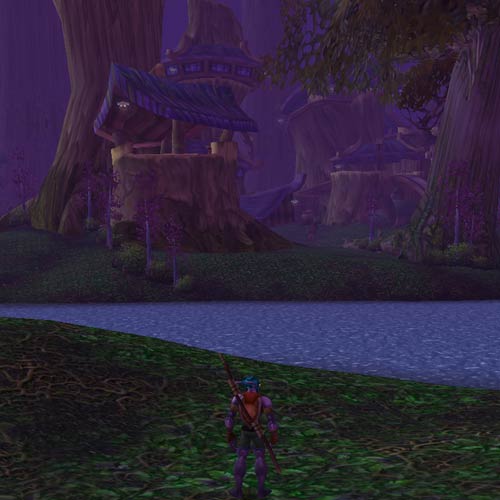World of Warcraft Performance Guide
by Anand Lal Shimpi on March 23, 2005 12:17 PM EST- Posted in
- GPUs
In PC gaming, first person shooters get all of the attention. The releases of Doom 3 and Half Life 2 were accompanied by a swarm of hardware upgrade guides all over the net, including those published on AnandTech. If you were waiting for Doom 3 or Half Life 2 before upgrading your machine, you had every ounce of information at your disposal upon their release.
The same type of attention is rarely cast on other genres of games in the PC world for a handful of reasons. For starters, FPSes are the most likely to have built-in benchmarking tools, making our ability to present you with performance data infinitely easier. There's also a good deal of emotional attachment to anything that comes out of id Software, Epic Games or Valve, given their history with PC games - in their own way, they are the developers who brought the PC its Super Mario Brothers or Legend of Zelda. But reasoning aside, there's much more to PC gaming than just FPSes; the best, most recent, example of an extremely successful non-fps is none other than Blizzard's foray into the Massively Multiplayer Online Role Playing realm - World of Warcraft.
MMORPGs, like World of Warcraft, rely on hordes of subscribed users (hence the massively multiplayer aspect); otherwise, they lose a big chunk of their appeal. World of Warcraft has been particularly successful in this respect. Earlier this month, Blizzard announced that WoW had reached over 1.5 million subscribers worldwide, with over 800,000 subscribers in North America alone. At any given time, there are over 500,000 users logged into one of Blizzard's many WoW servers at a speed of adoption never before seen in the MMORPG market. But as we saw with the introduction of Warcraft III, anything Warcraft from Blizzard is not only well done, but turns to gold upon release.
Given the tremendous market penetration of WoW, we felt that it was time to take a look at its performance demands. But unlike Doom 3 and Half Life 2, there is no static element of WoW gameplay - everything takes place in an ever-changing online world. The result is that finding a repeatable benchmark to run is fairly difficult...but not impossible. As a MMORPG, World of Warcraft doesn't depend on the razor-sharp reaction time of a fast-paced first person shooter; instead, you spend most of your time walking around performing quests and battling at a much slower pace, in a much larger, more interactive world. As such, there are two scenarios when performance in WoW becomes an issue: when a lot of characters are present on the screen, and simply rotating the camera in the world. The former is a virtually impossible scenario to use as a benchmark, as you can't reliably get a bunch of people to do the exact same thing at the exact same time in a repeatable fashion, but the same can't be said about scenario 2. The world of Warcraft is truly enormous and in order to prevent overcrowding, there is a large number of servers for you to choose on which your character may play - each server has a complete copy of the Warcraft world. Even on the highest populated servers (one of which we conducted our test), there are many areas where you can go that are devoid of any player controlled characters - making them ideal for benchmarking. We chose one such spot in the Night Elf city of Darnassus.
The other aspect of WoW that played into our favor was the fact that exiting and returning to the game using the same character always put you in the world at the exact same place. Equipped with FRAPS, we were able to get an extremely repeatable average frame rate out of a sequence of five full camera rotations in our chosen spot in Darnassus. The number of rotations ensured that minor variations such as a squirrel walking across the screen would have minimal impact on the benchmark, and the results backed that up. We found a maximum of 3% variation between runs as long as there was no disk swapping that occurred during the benchmark (more on that later). The only downside is that our benchmark is not externally reproducible, but similar techniques can be used to achieve a similar end result. We did have one user search us out in the world and interrupt our benchmarking by asking us if we had any linen cloth, but after a quick "no", we were back to benchmarking without being disturbed.
Graphically, WoW isn't another Doom 3 or Half Life 2; it's not pushing the limits of DirectX 9 nor is it going to knock your socks off visually. For a MMORPG, it looks pretty good, similar to Warcraft III, but obviously much more detailed, since you are taking the perspective of a single character in the world of Warcraft, rather than controlling an army from up above.
Blizzard states the minimum GPU requirement as a GeForce 2; while a GeForce 2 will run the game just fine at lower resolutions and detail settings, it will do so at the sacrifice of a good amount of image quality. Below, we have a comparison between a playable WoW system on a GeForce4 MX (GeForce 2 class DirectX 7 hardware) and on a Radeon X800 (DX9 hardware). You'll see a DX7 screenshot, and mouse over to see the same scene running on DX9 hardware:
As you can see, the improvement from older hardware to newer DX9 cards is fairly significant.
The same isn't necessarily true for DirectX 8 hardware, as the GeForce4 looks just as good as the X800, just slower, in WoW.
Below, you'll see a DX8 screenshot, and mouse over the image to see the DX9 version:
How much slower is a GeForce4 than a Radeon X800? That comparison and many more is the subject of our first comparison...
The Test
Our hardware configurations are similar to what we've used in previous comparisons.
AMD Athlon 64 Configuration
Socket-939 Athlon 64 CPUs
2 x 512MB OCZ PC3200 EL Dual Channel DIMMs 2-2-2-10
NVIDIA nForce4 Reference Motherboard and MSI K8N-Neo2 (nForce3) for AGP tests
Intel Pentium 4 Configuration
LGA-775 Intel Pentium 4 and Extreme Edition CPUs
2 x 512MB Crucial DDR-II 533 Dual Channel DIMMs 3-3-3-12
Intel 925XE Motherboard
AMD Athon XP Configuration
Athlon XP 3200+ Barton CPU
2 x 512MB OCZ PC3200 EL Dual Channel DIMMs 2-2-2-10
ASUS nForce2 Motherboard
ATI's Catalyst 5.3 and NVIDIA's ForceWare 71.84 Drivers were used.












59 Comments
View All Comments
trs80m1 - Wednesday, March 23, 2005 - link
Great article, though I was disappointed to see that the ATI 9600XT (my card, of course) got left off. Hope you get a chance to add that, since I'd like to keep that card when I build a new A64 system soon.Two other requests: City of Heroes performance review, and how does the Internet connection affect framerate? i.e. Cable vs DSL vs Dial-up
Thanks again!
segagenesis - Wednesday, March 23, 2005 - link
I dont think WoW even supports AA, at least on my card (read above). I force enable it outside and it works up to the character selection screen, but in game it goes away (back to jaggies). What gives?Glayde - Wednesday, March 23, 2005 - link
Hey I want to say thanks for doing comparisons on a game I play, it's hard to compare other benchmarks to actual results i'd get in game.One thing I'd like to ask about though, none of your tests were with AA enabeled? (since AA isn't changed in-game in WoW, you need to do it out of game).
cHodAXUK - Wednesday, March 23, 2005 - link
Nice article, how about a look at EQ2 and DAoC Catacombs as well? The later has just had a major DX9 engine upgrade and all the old art/textures/models have been overhauled.Gholam - Wednesday, March 23, 2005 - link
Heh, approaching Orgrimmar auction house/bank area in prime time really puts the stress on any system :) I have a Winchester running at 2.6GHz and a 6800GT PCIe at 420/1200, and it's still a little choppy there, especially on initial approach, although I suspect that is due to bunches of textures being loaded.Anand Lal Shimpi - Wednesday, March 23, 2005 - link
For this particular test LOD didn't dramatically influence performance, but you all right, if it does annoy you turning the option off definitely helps.sbuckler
That comment was made for lower clocked Northwoods, I've made the appropriate clarification in the review.
Illissius
The big difference ends up being in overall smoothness of gameplay, which is determined by minimum frame rates as well as averages. Unfortunately due to the nature of the test being non deterministic not all of the minimum frame rates make total sense, thus we left those statistics out.
Take care,
Anand
WooDaddy - Wednesday, March 23, 2005 - link
My favorite part about the review is on the last page:"And as always we found that the Extreme Edition is a waste of money"
I think anyone who is BUILDING a computer who uses a Intel processor for GAMING is nucking futz! I mean how many AT reviews do you have to read until you get it in your think skull that Intel is absolutely not the best way to go for gaming!?!</rant off>
Sorry about that... Seriously, though. Good review. Time to upgrade the Ti4200 128Mb. I've been waiting for a review like this.
Illissius - Wednesday, March 23, 2005 - link
The 6600GT is only 15% slower than the 6800GT? That seems rather very odd...OrSin - Wednesday, March 23, 2005 - link
Alittle off subject can we get beachmarks with some RTS games too. Thier was time when they were all 2d games, but now alot of them are 3d now. Kohan 2, and Axis and Allies both use the Grybo engine. This engine is used in quite a few RTS games. Most games have in game films so you can re-run the film to test thier game play.Thanks.
EODetroit - Wednesday, March 23, 2005 - link
Interesting, I might have to try that some time, thanks for the quick reply on resolutions... might let me see a wider FoV, useful for PvP.